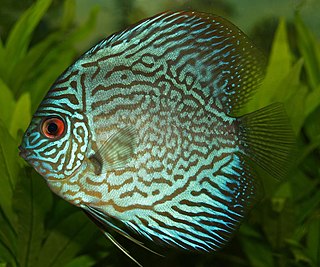
The Juruá River is a southern affluent river of the Amazon River west of the Purus River, sharing with this the bottom of the immense inland Amazon depression, and having all the characteristics of the Purus as regards curvature, sluggishness and general features of the low, half-flooded forest country it traverses.

The Purus River is a tributary of the Amazon River in South America. Its drainage basin is 371,042 km2 (143,260 sq mi), and the mean annual discharge is 11,207 m3/s (395,800 cu ft/s). The river shares its name with the Alto Purús National Park and the Purús Province, one of the four provinces of Peru in the Ucayali Region.

Symphysodon is a genus of cichlids native to the Amazon river basin in Brazil. Due to their distinctive shape, calm behavior, many bright colors and patterns, and dedicated parenting techniques, discus are popular as freshwater aquarium fish, and their aquaculture in several countries in Asia is a major industry. They are sometimes referred to as pompadour fish. The discus fish has attracted a cult following of collectors and has created a multimillion dollar international industry complete with shows, competitions, and reputable online breeders.

Coari (Choary) is a municipality located in the Brazilian state of Amazonas.
Alto Purús National Park is a national park in the Amazon rainforest of Peru, established in 2004. It covers an area of 2,510,694.41 ha (9,693.85 sq mi) in the provinces of Purús (Ucayali), Tahuamanu and Tambopata.

Dasypogoninae is a subfamily of robber flies in the family Asilidae. There are more than 60 genera and 520 described species in Dasypogoninae.

The Purus várzea (NT0156) is an ecoregion of seasonally flooded várzea forest in the central Amazon basin. It is part of the Amazon biome. The ecoregion is home to a vegetation adapted to floods of up to 12 metres (39 ft) that may last for eight months. There is a great variety of fish and birds, but relatively fewer mammals. Ground-dwelling mammals must migrate to higher ground during the flood season. Threats include logging, cattle farming, over-fishing and mercury pollution from gold mining.

The Purus-Madeira moist forests (NT0157) is an ecoregion in the central Amazon basin. It is part of the Amazon biome. The ecoregion covers a stretch of flat and relatively infertile land between the Purus and Madeira rivers, extending to the Solimões River in the north. It is isolated from other regions by the seasonally flooded várzea forest along these rivers, and has a high degree of endemism among its flora and fauna. The natural environment is relatively intact. The BR-319 highway was built along the length of the ecoregion in the early 1970s, but rapidly deteriorated and is now closed.

The Juruá–Purus moist forests (NT0133) is an ecoregion in northwest Brazil in the Amazon biome. The terrain is very flat and soils are poor. The rivers flood annually. There are no roads in the region, and the dense rainforest is relatively intact, although plans to extend the Trans-Amazonian Highway through the region would presumably cause widespread damage to the habitat.
Saropogon hypomelas is a species of robber flies.

Saropogon is a genus of robber flies. There are at least 120 described species in Saropogon.

Saropogon luteus is a species of robber flies.
Saropogon bryanti is a species of robber flies.
Saropogon nitidus is a species of robber flies.
Saropogon dispar is a species of robber flies.
Saropogon mohawki is a species of robber flies.

Saropogon pritchardi is a species of robber flies.
Saropogon abbreviatus is a species of robber flies.











